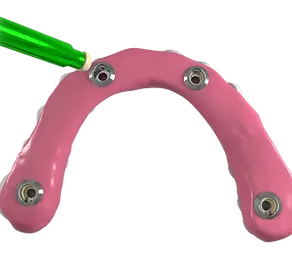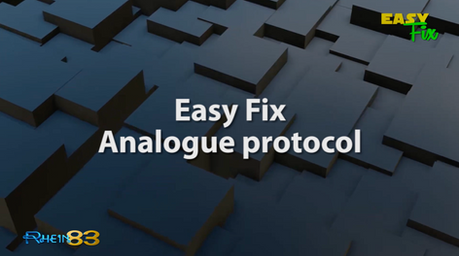OT Equator For Implants
With a low vertical profile of 2.1 mm and diameter of 4.4 mm, the OT Equator is the smallest attachment system on the market. This system offers multiple solutions for overdenture treatment planning when vertical space limitations are a consideration.
Available in two versions, castable and prefabricated titanium abutments which are compatible with any implant brand on the market and manufactured with cuff heights from .5 mm to 7 mm. Female caps are retained by means of a stainless steel housing ranging in four levels of retention, making it easy to process at the dental laboratory or chair side in the dental office.
The unique design and exceptionally low 2.1 mm profile of the OT Equator 4 in 1 System provides exceptional stability and superior retention when compared with other attachment systems. Due to it's lower radius, OT Equator is indicated to correct divergence up to 28 degrees between implants without affecting the functionality of the nylon cap. A complete line of OT Equator accessories and tools are also available.
ATTENTION: Where implant divergence exceed the maximum 28 degrees, Sphero Block and Sphero Flex are recommended case plan options.
OT Equator For Implants
With a low vertical profile of 2.1 mm and diameter of 4.4 mm, the OT Equator is the smallest attachment system on the market. This system offers multiple solutions for overdenture treatment planning when vertical space limitations are a consideration.
Available in two versions, castable and prefabricated titanium abutments which are compatible with any implant brand on the market and manufactured with cuff heights from .5 mm to 7 mm. Female caps are retained by means of a stainless steel housing ranging in four levels of retention, making it easy to process at the dental laboratory or chair side in the dental office.
The unique design and exceptionally low 2.1 mm profile of the OT Equator 4 in 1 System provides exceptional stability and superior retention when compared with other attachment systems. Due to it's lower radius, OT Equator is indicated to correct divergence up to 28 degrees between implants without affecting the functionality of the nylon cap. A complete line of OT Equator accessories and tools are also available.
ATTENTION: Where implant divergence exceed the maximum 28 degrees, Sphero Block and Sphero Flex are recommended case plan options.


Introducing Equator Easy Fix
Your new go-to solution for fixed and removable restorations—engineered for compatibility, performance, and simplicity without the need of screws and costly multi-unit abutments.
Easy Fix is the patented solution by Rhein83 designed to create screwless full-arch fixed prosthetic structures. Thanks to a special release key, the restorations can be easily removed and inspected in a simple, non-invasive manner.
The innovative T-Base houses a new PEEK Seeger ring, which allows for angulation correction up to 60°. The system requires only one access hole for unlocking, which can be strategically placed in the most convenient and aesthetic location within the prosthetic design—preserving both functionality and appearance of the restoration.
The retention of the fixed prosthesis is managed using three different Seeger ring retention levels, which can be adapted according to the number of implants present.
Easy Fix combines control, safety, and design flexibility in a single solution, enabling clinicians to work with any implant platform and diameter counting on the OT Equator abutments.
Designed to meet the everyday needs of modern dental professionals, Easy Fix combines:
-
A universal, narrow-profile abutment adaptable to ALL implant platforms
-
Protocols that simplify prosthesis construction while enhancing low profile aesthetics
-
A biological seal comparable to T-Base systems—without the cost
-
Innovative solutions like the Highly Retentive Seeger Connection Rings that reduce components eliminating secondary screws and MUA’s
-
Fully supported digital workflows, from design to immediate loading
Scroll down to view advantages and operating protocol.
Main advantages of Easy-Fix
1. Simple prosthesis removal
To unlock the Easy Fix prosthesis, only 1 hole must be left to insert the Unlocking Tool. By screwing the unlocking tool into the Easy Fix T-Base the prosthesis will be lifted allowing atraumatic removal of the prosthesis.


2. You choose where to place the release hole
Using the Easy Fix system you have the option of leaving only 1 release hole
in the most aesthetically and functionally convenient location for your prosthetic project.




3. Manage the tightness of the prosthesis
Thanks to three different retention forces of the Seeger ring, it is possible to manage the correct retention of the prosthesis in relation to the number of implants.
Optional safety screw to be used in the release hole.
The Seeger ring is inserted inside the T-Base Easy Fix with the special insertion tool.
The opening of the Seeger will correspond to the ‘Extragrade’ portion of the Easy Fix T-Base.



Analog Operating Protocol
OT Equator attachments placed in the patient’s mouth.

Plaster model with Easy Fix T-Base with fixing screw and laboratory seeger.

OT Equator attachments placed in the patient’s mouth.

Screw the Titanium Transfers onto the Ot Equator attachments to proceed with the impression.

Place the castable sleeves on the Easy Fix T-Base

OT Equator attachments placed in the patient’s mouth.

Plaster working model with laboratory analogues.

Designing a structure

OT Equator attachments placed in the patient’s mouth.

Digital Operating Protocol
Ot Equator attachments placed in the patient’s mouth.

Structure modelling with digital libraries

Easy Fix T-Base in place within the finished structure

Screw Scan Abutment OT Equator attachments with digital impression taking using an intraoral scanner.

Cement Easy Fix T-Base inside the milled structure with OT Cem cement.

Finished work with hole for unlocking tool in position 16*

Plaster working model with laboratory analogs

illed structure with T-Base cemented in place










